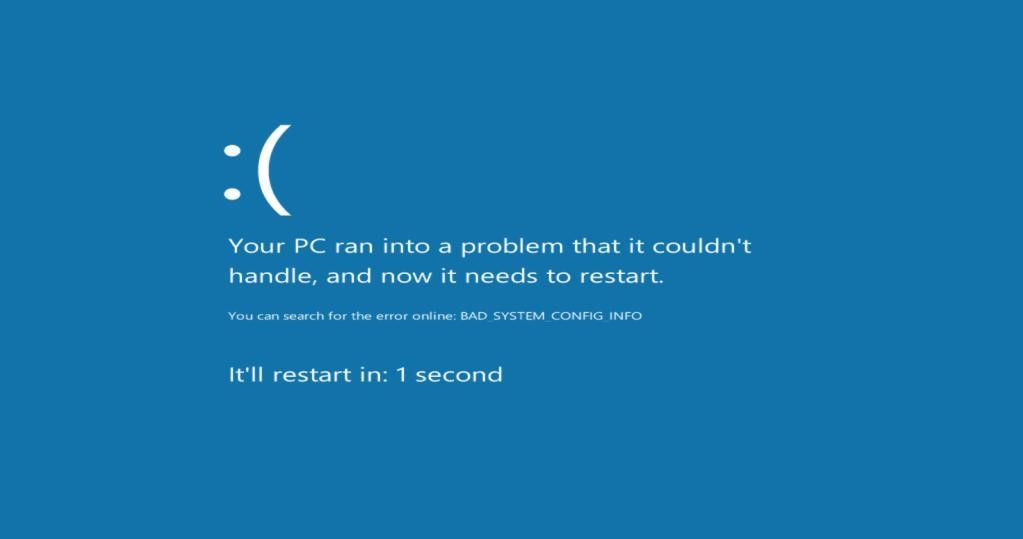| Cerchiamo di localizzare il nostro sito internet in quante più lingue possibili, tuttavia questa pagina è attualmente tradotta automaticamente utilizzando Google Translate. | chiudi |
-
-
prodotti
-
risorse
-
supporto
-
compagnia
-
Una guida alla schermata BAD_SYSTEM_CONFIG_INFO blu di errore di morteA Guide to the BAD_SYSTEM_CONFIG_INFO Blue Screen of Death Error
Da Steve Horton Maggio 30, 2013bad_system_config_info, Blue Screen of Death, bsod6 CommentsNome errore: BAD_SYSTEM_CONFIG_INFO
Codice STOP: 0x00000074
C’è una delle due ragioni per cui sei qui.
O stai aiutando un amico che sta vivendo questo particolare errore di Blue Screen of Death, o stai cercando di aggiustarlo da solo. Indipendentemente dai tuoi obiettivi, benvenuto – sei arrivato nel posto giusto. Se hai l’errore BAD_SYSTEM_CONFIG_INFO, la schermata risultante dovrebbe apparire così:

Sulle versioni di Windows precedenti a Windows 8.O questo:

Su Windows 8.Tutto su BAD_SYSTEM_CONFIG_INFO
Innanzitutto, l’errore BAD_SYSTEM_CONFIG_INFO è causato da errori nel registro del tuo computer. Con nomi come Blue Screen of Death e Registry che vengono lanciati in giro, probabilmente sei abbastanza preoccupato adesso – lasciami spiegare cosa sono queste cose prima di procedere.
Il registro del tuo computer è, più o meno, il suo sommario. Questo sommario è usato per localizzare tutto sul tuo computer, dal tuo sistema operativo al tuo browser web preferito, alle tue canzoni e ai tuoi giochi. Se il registro è danneggiato, specialmente le parti che portano al sistema operativo, questo errore si verificherà e il tuo computer risulterà probabilmente inutilizzabile per il momento.
Una schermata blu della morte è un errore riscontrato quando il tuo computer incontra qualcosa che non può elaborare. Si spegne per prevenire ulteriori danni e, nella maggior parte dei casi, è la fine delle tue preoccupazioni: la maggior parte delle persone non incontra mai più il BSoD e, anche se ha frequenti problemi con esso, di solito è risolvibile.
In questo caso, tuttavia, il danno arrecato è grave. Ci sono tre possibili problemi: memoria difettosa (RAM), un disco rigido difettoso o un programma che ha danneggiato il registro.
Per testare il primo, rimuovere gli stick di RAM e lasciarne solo uno, testando quale stick non permetterà al sistema di avviarsi. Se nessuno di questi è la fonte del problema, non è un problema di RAM – e se non sai come fare, prendi un tecnico.
Successivamente, dovresti provare a consentire a Windows di utilizzare Ripristino all’avvio per risolvere il tuo problema o avviare da un’ultima configurazione sicuramente funzionante. Se nessuno dei due funziona, è necessario sostituire il disco rigido, perché il disco rigido è difettoso o un programma ha danneggiato il registro in modo irreparabile.
Puoi anche provare il nostro Registry Reviver e vedere se la sua pulizia del registro e le sue proprietà di ottimizzazione possono chiarire questo particolare errore.
Per ulteriore assistenza, contattare il produttore o Microsoft.
Was this post helpful?YesNoGratis Aggiornamenti dei driver
Aggiorna i tuoi driver in meno di 2 minuti per divertirti al meglio Prestazioni del computer - Gratis.
Gratis Aggiornamenti dei driver
Aggiorna i tuoi driver in meno di 2 minuti per divertirti al meglio
Prestazioni del computer - Gratis.
Non hai trovato la tua risposta?Posta una domanda alla nostra community di esperti provenienti da tutto il mondo e ricevere una risposta in pochissimo tempo.più rilevanti articoli recenti Appuntalo su Pinterest